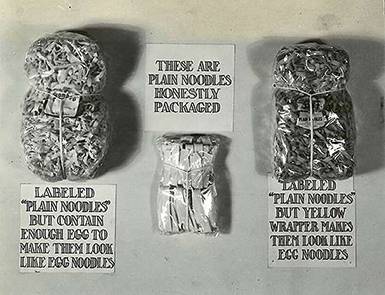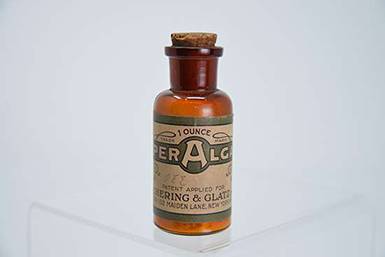The American Chamber of Horrors

Dr. Harvey Wiley spent a good majority of his time at the US Department of Chemistry trying to push through a law that would set some standard for honest food labeling and ensuring consumer safety, resulting in the Pure Food and Drug Act of 1906. Though this act was a good first step for the pure food movement, there were some inadequacies and limitations that ultimately made the law ineffective.
Despite the passing of Wiley’s law, after Wiley’s death in 1930, manufacturers continued to put out faulty products at the cost of the consumer’s well-being, prompting Kallet and Schlink’s 1933 book, 100,000,000 Guinea Pigs. This book then also prompted the FDA to put on a showing of faulty products for lawmakers to see how the Pure Food and Drug Act of 1906 had to be amended.
This display was later dubbed “The American Chamber of Horrors” by a reporter who accompanied First Lady Eleanor Roosevelt. This display of “horrors” consisted of products that had either inaccurate labeling or caused harm to consumers yet were out of the reach of the law.
The exhibit was started by the FDA’s Chief Education Officer, Ruth deForest Lamb, and their Chief Inspector, George Larrick

Photo: Ruth Lamb | The first federal food and drug law prohibiting … | Flickr
Many of the products that were in the Chamber of Horrors were out of the reach of the law because the Pure Food and Drug act did not cover cosmetics and only made misleading claims on labels unlawful (untrue claims were still not monitored in advertising and there were no restrictions on food packaging fraud).
Products with INACCURATE labeling:

Bowman’s Abortion Remedy: This product falsely claimed that it would treat Contagious Abortion in cattle. After the FDA won a seizure action against Bowman’s, the manufacturers took the misleading claims off of their labels and implemented them into their advertising because that was not technically illegal under the Pure Food and Drug Act of 1906.

Crazy Water Crystals: This product was allegedly derived from health-giving Crazy Mineral Water found in Texas and made claims to treat Bright’s disease, rheumatism, liver disorders, etc. Those claims were later moved from their labels to their advertising, just as with Bowman’s

Flavoring Extracts: As flavoring extracts were usually the most expensive items in the grocery store, they were also the products that were most often the source of packaging fraud. The two bottles to the left were both labeled as 2 oz bottles, but there is a very clear and significant difference between the two bottles with the labels removed.

Egg Noodles: Due to their nutritive value and generally higher price tag, these noodles were another common source of labeling fraud. As shown in the image to the right, producers would defraud customers by marketing their products as egg noodles, when in reality, they were not.
Products with Dangerous Side-Effects:
Dinitrophenol: This industrial chemical was utilized to accelerate the metabolism and produce weight loss, but ultimately, caused fatal blood disorders, cataracts, and other serious side effects. Because of the substances classification as a cosmetic products rather than a drug, it was beyond the reach of the law.

Koremlu: This supposedly revolutionary beauty product eliminated unwanted hair, becoming a very sought after product and selling over 120,000 jars within its first year. The main depilatory agent was thallium acetate, which was a common rodenticide that can cause neuro-muscular damage, respiratory problems, blindness, and permanent hair-loss. One woman reportedly lost her teeth, eyesight, ability to walk, and her job due to Koremlu.

Lash Lure: A coal tar-based eyelash and eyebrow dye which contained a toxic dye that was highly irritating and caused eyebrow and eyelash loss, as well as vision impairment and even blindness.

Othine: This product utilized mercury as a means to remove brown spots and lighten skin, ultimately, putting consumers at risk of bone deterioration, tooth loss, neurological, pulmonary, and renal damage, cognitive and sensory impairment, and even death.

Peralga: An advertised weight- loss remedy that contained amidopyrine and barbiturates which led to agranuloctyosis, a dangerous loss of white blood cells, in some women, resulting in an inability to fight off infection and often times death.
Olivia Poches
Student Assistant, Go Big Read Office
Sources: 80 Years of the Federal Food, Drug, and Cosmetic Act | FDA